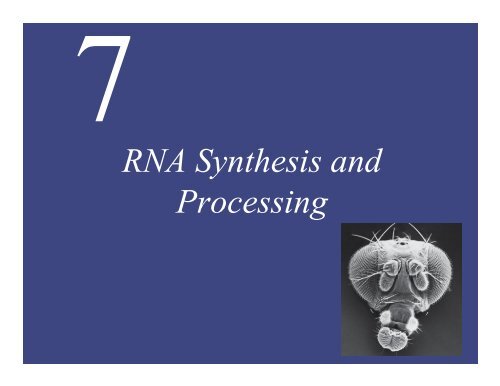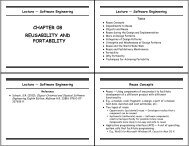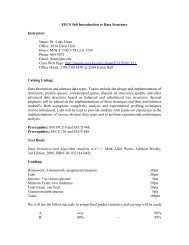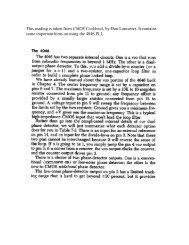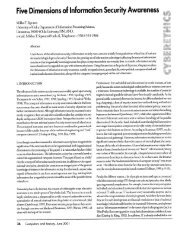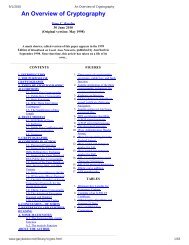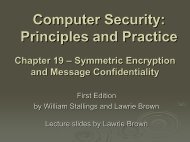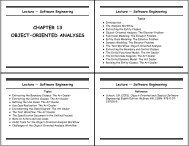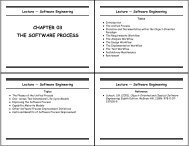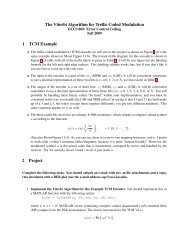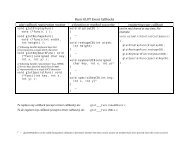RNA Synthesis and Processing
RNA Synthesis and Processing
RNA Synthesis and Processing
- No tags were found...
You also want an ePaper? Increase the reach of your titles
YUMPU automatically turns print PDFs into web optimized ePapers that Google loves.
<strong>RNA</strong> <strong>Synthesis</strong> <strong>and</strong><strong>Processing</strong>
OverviewGenome structureMendelian geneticsLinkage <strong>and</strong> recombination
Chromosome structureShort arm: plong arm: q
A few termsA chromosome contains two (almost) identicalcopies of DNA molecules. Each copy is called achromatid <strong>and</strong> two chromatids are joined at theircentromeres.Chromosomes <strong>and</strong> regions in a chromosome arenamed. For example by notation 6p21.3, wemean• 6 : chromosome number• p : short arm (from petit in French), q for longarm• 21.3 : b<strong>and</strong> 21, sub-b<strong>and</strong> 3 (microscope)
Chromosomes in Cell Division
Chromosome Structure
Chromosome structure
Mendelian GeneticsMendel started genetics research before we knowchromosome <strong>and</strong> genePhenotype-- observable difference amongmembers in a population• For example: hair color, eye color, blood typeWhat controls a phenotype?• This is the question that Mendel tried toanswer• Is still the central question of modern geneticsHe used pea, a simple organism, <strong>and</strong> quantitativemethod to study phenotypes.• We call a quantitative study of biologycomputational biology now.
Gene linkageExperiments: white eyed female flies cross with wild typemales (red eye, dominant)What should we expect:• All red eyed flies in F1No! We have 50% red eyed <strong>and</strong> 50% white eyed• Why?• A further study show that all red eyed are female <strong>and</strong>all white eyed are male
Gene Linkage:Morgan’s explanation:wwX+Yw+wYFemale, red eyeMale, while eye
RecombinationF1 generation: white eyed, miniature wingfemale crossed to wild type maleF2 generation (ie. heterozygous femalecrossed to a wm male.We know that white eye gene <strong>and</strong> theminiature gene are in the samechromosomeWhat should we expect:• female: 50% wm, 50% normal• male: 50% wm, 50% normal
RecombinationWhat we have: F2 generation (ie. heterozygous femalecrossed to a wm male:• white eyes, normal wings 223• red eyes, miniature wings 247• red eyes, normal wings 395• white eyes, miniature wings 382We have some combination that does not appear inparents!
Recombinationchromtides exchange their DNAcomponents.
Modern GeneticsForward genetics: given a phenotype,how do we identify the genes thatcontribute to the phenotype?•Cancer, Parkinson's Disease,…Reverse genetics: given a gene, howcould we know what are thephenotype that the gene mightcontrol?•Diagnostics
How are Phenotypes Caused?Through a biochemical pathways:A W B X C Y D ZEGenes, m<strong>RNA</strong>, <strong>and</strong> proteins
Chromosome structure
Chromosome StructureChromosomes are made up of a single continuous DNA moleculecan’t be straight-- would be many times length of the cellChromatin: ordered aggregate of DNA<strong>and</strong> proteins visible in the cell cycle
Chromosome Structureheterochromatin: dense, compact structure during interphasegenerally near the centromere <strong>and</strong> telomeres (chromosome ends)composed of long tracks of fairly short base pair repeatsfew genes compared to euchromatineuchromatin: less dense DNA that only becomes visible after condensingtypically has genes being actively transcribed
Gene Expression• genes are located at specific places on thechromosome (loci)• regions corresponding to genes aretranscribed• sequences flanking the coding sequencecontrol the start <strong>and</strong> stop of transcription• not all genes are expressed at the samerates or at the same times}
<strong>RNA</strong> <strong>Synthesis</strong> <strong>and</strong> <strong>Processing</strong>• Transcription in Prokaryotes• Eukaryotic <strong>RNA</strong> Polymerases <strong>and</strong>General Transcription Factors• Regulation of Transcription inEukaryotes• <strong>RNA</strong> <strong>Processing</strong> <strong>and</strong> Turnover
IntroductionRegulation of gene expression allowscells to adapt to environmentalchanges <strong>and</strong> is responsible for thedistinct activities of the differentiatedcell types that make up complexorganisms.
Transcription in Prokaryotes<strong>RNA</strong> polymerase catalyzespolymerization of ribonucleoside 5′-triphosphates (NTPs) as directed by aDNA template, always in the 5′ to 3′direction.Transcription initiates de novo (nopreformed primer required) at specificsites—this is a major step at whichregulation of transcription occurs.
Figure 7.5 Structure of bacterial <strong>RNA</strong> polymerase
Figure 7.1 E. coli <strong>RNA</strong> polymerase
Figure 7.2 Sequences of E. coli promoters
Figure 7.4 Transcription by E. coli <strong>RNA</strong> polymerase (Part 1)
Figure 7.4 Transcription by E. coli <strong>RNA</strong> polymerase (Part 2)
Transcription in ProkaryotesTranscription of the GC-rich invertedrepeat results in a segment of <strong>RNA</strong> thatcan form a stable stemloop structure.This disrupts its association with theDNA template <strong>and</strong> terminatestranscription.
Figure 7.6 Transcription termination
Figure 7.8 Negative control of the lac operon
Transcription in ProkaryotesCis-acting control elements only affectthe expression of linked genes on thesame DNA molecule (e.g. the operator).Trans-acting factors can affectexpression of genes located on otherchromosomes (e.g. the repressor).The lac operon is an example of negativecontrol—binding of the repressor blockstranscription.
Transcription in ProkaryotesAn example of positive control in E. coli :Presence of glucose (the preferredenergy source) represses expressionof genes for enzymes that breakdown other sugars, such as the lacoperon.
Transcription in ProkaryotesLow glucose levels activate adenylylcyclase, which converts ATP to cAMP.cAMP then binds to catabolite activatorprotein (CAP).CAP then binds to its target DNAsequences, 60 bases upstream of thetranscription start site in the lac operon.
Figure 7.9 Positive control of the lac operon by glucose
Eukaryotic <strong>RNA</strong> Polymerases <strong>and</strong> General Transcription FactorsEukaryotic cells have three nuclear <strong>RNA</strong>polymerases that transcribe differentclasses of genes.They are complex enzymes, consistingof 12 to 17 different subunits each.They all have 9 conserved subunits, 5 ofwhich are related to subunits ofbacterial <strong>RNA</strong> polymerase.
Figure 7.10 Structure of yeast <strong>RNA</strong> polymerase II
Eukaryotic <strong>RNA</strong> Polymerases <strong>and</strong> General Transcription FactorsPromoters contain several differentregulatory sequence elements.Promoters of different genes containdifferent combinations of promoterelements, which appear to functiontogether to bind general transcriptionfactors.
Figure 7.13 <strong>RNA</strong> polymerase II/Mediator complexes <strong>and</strong> transcription initiation
Figure 7.14 The ribosomal <strong>RNA</strong> gene
Regulation of Transcription in EukaryotesSome regulatory sequences are fartheraway—called enhancers.They were first identified during studiesof the promoter of another virus, SV40.
Figure 7.19 The SV40 enhancer
Regulation of Transcription in EukaryotesActivity of enhancers doesn’t depend oneither their distance from, or orientationwith respect to, the transcriptioninitiation site.
Figure 7.20 Action of enhancers (Part 1)
Figure 7.20 Action of enhancers (Part 2)
Figure 7.21 DNA looping
Regulation of Transcription in EukaryotesChromatin immunoprecipitationidentifies DNA regions that bind totranscription factors.Cells are treated with formaldehyde tocross-link transcription factors to the DNAsequences to which they were bound.Chromatin is extracted <strong>and</strong> fragmented.Fragments of DNA linked to atranscription factor can then be isolatedby immunoprecipitation.
Figure 7.25 Chromatin immunoprecipitation (Part 1)
Figure 7.25 Chromatin immunoprecipitation (Part 2)
Regulation of Transcription in EukaryotesOne of the first transcription factors to beisolated was Sp1, in studies of virusSV40 DNA, by Tjian <strong>and</strong> colleagues.Sp1 binds to GC boxes in the SV40promoter. This established the action ofSp1 <strong>and</strong> also suggested a method forpurification of transcription factors.
Key Experiment 7.1 Isolation of a Eukaryotic Transcription Factor: Purification of Sp1
Figure 7.28 Examples of DNA-binding domains (Part 1)
Figure 7.28 Examples of DNA-binding domains (Part 2)
Regulation of Transcription in EukaryotesThe most common is the zinc fingerdomain, which binds zinc ions <strong>and</strong>folds into loops (“fingers”) that bindDNA.Steroid hormone receptors containzinc fingers; they regulate genetranscription in response to hormonessuch as estrogen <strong>and</strong> testosterone.
Regulation of Transcription in EukaryotesHelix-turn-helix domain: one helixmakes most of the contacts with DNA,the other helices lie across the complexto stabilize the interaction.They include homeodomain proteins,important in the regulation of geneexpression during embryonicdevelopment.
Regulation of Transcription in EukaryotesHomeodomain proteins were firstdiscovered as developmental mutantsin Drosophila.They result in development of flies inwhich one body part is transformed intoanother.In Antennapedia, legs rather thanantennae grow from the head.
Figure 7.29 The Antennapedia mutation
Regulation of Transcription in EukaryotesLeucine zipper <strong>and</strong> helix-loop-helixproteins contain DNA-binding domainsformed by dimerization of twopolypeptide chains.Different members of each family c<strong>and</strong>imerize with one another—combinations can form an exp<strong>and</strong>edarray of factors.
Regulation of Transcription in EukaryotesThe activation domains of transcriptionfactors are not as well characterized astheir DNA-binding domains.Activation domains stimulatetranscription by two mechanisms:• Interact with Mediator proteins <strong>and</strong>general transcription factors• Interact with coactivators to modifychromatin structure.
Figure 7.30 Action of transcriptional activators
Regulation of Transcription in EukaryotesGene expression in eukaryotic cells isalso regulated by repressors whichbind to specific DNA sequences <strong>and</strong>inhibit transcription.In some cases, they simply interfere withbinding of other transcription factors.Other repressors compete withactivators for binding to specificregulatory sequences.
Figure 7.33 Decondensed chromosome regions in Drosophila
Regulation of Transcription in EukaryotesHistone modification provides amechanism for epigenetic inheritance—transmission of information that is notin the DNA sequence.Modified histones are transferred to bothprogeny chromosomes where they directsimilar modification of new histones—maintaining characteristic patterns ofhistone modification.
Figure 7.36 Epigenetic inheritance of histone modifications (Part 1)
Figure 7.36 Epigenetic inheritance of histone modifications (Part 2)
Regulation of Transcription in EukaryotesChromatin remodeling factors areprotein complexes that alter contactsbetween DNA <strong>and</strong> histones.They can reposition nucleosomes,change the conformation ofnucleosomes, or eject nucleosomesfrom the DNA.
Figure 7.37 Chromatin remodeling factors
Regulation of Transcription in EukaryotesTranscription can also be regulated bynoncoding <strong>RNA</strong> molecules, includingsmall-interfering <strong>RNA</strong>s (si<strong>RNA</strong>s) <strong>and</strong>micro<strong>RNA</strong>s (mi<strong>RNA</strong>s).They can induce histone modificationsthat lead to chromatin condensation<strong>and</strong> formation of heterochromatin.
Regulation of Transcription in EukaryotesIn the yeast S. pombe, si<strong>RNA</strong>s directformation of heterochromatin atcentromeres, by associating with the<strong>RNA</strong>-induced transcriptional silencing(RITS) complex.RITS includes proteins that inducechromatin condensation <strong>and</strong>methylation of histone H3 lysine-9.
Figure 7.38 Regulation of transcription by si<strong>RNA</strong>s
Regulation of Transcription in EukaryotesDNA methylation is another generalmechanism that controls transcriptionin eukaryotes.Methyl groups are added at the 5-carbonposition of cytosines (C) that precedeguanines (G) (CpG dinucleotides).
Figure 7.40 DNA methylation
Regulation of Transcription in EukaryotesMethylation is common in transposableelements, it plays a key role insuppressing the movement oftransposons.DNA methylation is associated withtranscriptional repression of somegenes, <strong>and</strong> also has a role in Xchromosome inactivation.
Regulation of Transcription in EukaryotesDNA methylation is a mechanism ofepigenetic inheritance.Following DNA replication, an enzymemethylates CpG sequences of adaughter str<strong>and</strong> that is hydrogenbondedto a methylated parentalstr<strong>and</strong>.
Figure 7.41 Maintenance of methylation patterns
Regulation of Transcription in EukaryotesDNA methylation also plays a role ingenomic imprinting: expressiondepends on whether they are inheritedfrom the mother or from the father.Example: gene H19 is transcribed onlyfrom the maternal copy. It is specificallymethylated during the development ofmale, but not female, germ cells.
Figure 7.42 Genomic imprinting
<strong>RNA</strong> <strong>Processing</strong> <strong>and</strong> TurnoverMost newly-synthesized <strong>RNA</strong>s must bemodified, except bacterial <strong>RNA</strong>s whichare used immediately for proteinsynthesis while still being transcribed.r<strong>RNA</strong>s <strong>and</strong> t<strong>RNA</strong>s must be processed inboth prokaryotic <strong>and</strong> eukaryotic cells.Regulation of processing steps providesanother level of control of geneexpression.
<strong>RNA</strong> <strong>Processing</strong> <strong>and</strong> TurnoverThe ribosomal <strong>RNA</strong>s of both prokaryotes<strong>and</strong> eukaryotes are derived from asingle long pre-r<strong>RNA</strong> molecule.5S r<strong>RNA</strong> in eukaryotes is transcribedfrom a separate gene.
Figure 7.43 <strong>Processing</strong> of ribosomal <strong>RNA</strong>s
<strong>RNA</strong> <strong>Processing</strong> <strong>and</strong> Turnovert<strong>RNA</strong>s also start as long precursormolecules (pre-t<strong>RNA</strong>s), in bothprokaryotes <strong>and</strong> eukaryotes.<strong>Processing</strong> of the 5′ end of pre-t<strong>RNA</strong>sinvolves cleavage by the enzymeRNase P.RNase P is a ribozyme—an enzyme inwhich <strong>RNA</strong> rather than protein isresponsible for catalytic activity.
<strong>RNA</strong> <strong>Processing</strong> <strong>and</strong> Turnover<strong>RNA</strong> editing is processing (other thansplicing) that alters the protein-codingsequences of some m<strong>RNA</strong>s.It involves single base modificationreactions such as deamination ofcytosine to uridine <strong>and</strong> adenosine toinosine.
<strong>RNA</strong> <strong>Processing</strong> <strong>and</strong> TurnoverUltimately, <strong>RNA</strong>s are degraded in thecytoplasm.Intracellular levels of any <strong>RNA</strong> aredetermined by a balance betweensynthesis <strong>and</strong> degradation.Rate of degradation can thus controlgene expression.
<strong>RNA</strong> <strong>Processing</strong> <strong>and</strong> TurnoverBacterial m<strong>RNA</strong>s are rapidly degraded,most have half-lives of 2 to 3 minutes.Rapid turnover allows the cell to respondquickly to changes in its environment,such as nutrient availability.
<strong>RNA</strong> <strong>Processing</strong> <strong>and</strong> TurnoverIn eukaryotic cells, m<strong>RNA</strong> half-lives vary;less than 30 minutes to 20 hours inmammalian cells.Short-lived m<strong>RNA</strong>s code for regulatoryproteins, levels of which can vary rapidlyin response to environmental stimuli.m<strong>RNA</strong>s encoding structural proteins orcentral metabolic enzymes have longhalf-lives.
<strong>RNA</strong> <strong>Processing</strong> <strong>and</strong> TurnoverDegradation of eukaryote m<strong>RNA</strong>s isinitiated by shortening of the poly-Atails.Rapidly degraded m<strong>RNA</strong>s often containspecific AU-rich sequences near the 3′ends which are binding sites forproteins that can either stabilize themor target them for degradation.
Figure 7.56 m<strong>RNA</strong> degradation
<strong>RNA</strong> <strong>Processing</strong> <strong>and</strong> TurnoverThese <strong>RNA</strong>-binding proteins areregulated by extracellular signals, suchas growth factors <strong>and</strong> hormones.Degradation of some m<strong>RNA</strong>s isregulated by both si<strong>RNA</strong>s <strong>and</strong> mi<strong>RNA</strong>.


